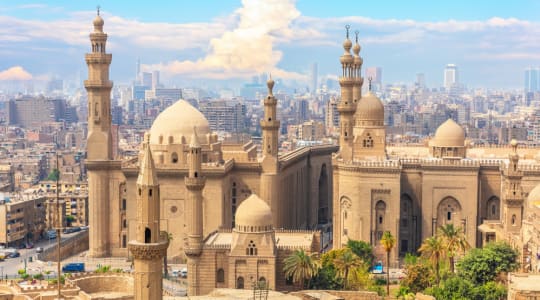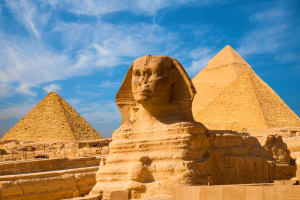
The Mosque-Madrassa of Sultan Hassan is a monumental Islamic complex located in the heart of Cairo, Egypt. It was built during the Mamluk Sultanate in the 14th century, between 1356 and 1363, under the reign of Sultan Hassan. The complex is considered to be one of the most impressive examples of Islamic architecture in Egypt and the world.
The complex consists of a mosque and a madrasa (Islamic school), both built on a large square plan. The mosque has a hypostyle prayer hall with four iwans (vaulted halls) and a central courtyard. The minaret of the mosque, located at the southeast corner, is one of the tallest in Egypt and has a unique square shape. The madrasa, located on the west side of the complex, has four iwans surrounding a central courtyard, and was designed to accommodate up to 1000 students.
The interior of the mosque is adorned with intricate decorations and calligraphy, including verses from the Quran. The domes and arches are also beautifully decorated with patterns and motifs in stone and plaster. The madrasa is equally impressive, with a central courtyard surrounded by vaulted halls and intricate decorations.
The Mosque-Madrassa of Sultan Hassan has undergone several renovations and restorations over the centuries, including a major restoration in the early 20th century. Today, it remains an important cultural and religious landmark in Cairo, attracting visitors from around the world who come to marvel at its stunning architecture and learn about the rich history of Islamic civilization in Egypt.
Explore Near The Mosque-Madrassa of Sultan Hassan
Discover 5 attractions, 5 cities, and 2 airports within 75km. Perfect for planning day trips, finding connecting flights, or discovering new destinations to explore during your visit.
Nearby Attractions & Places to Visit
5 destinations within 1.6km - 13.4km from your location





Nearby Cities Worth Exploring
5 destinations within 3.5km - 10.4km from your location
Airports Near The Mosque-Madrassa of Sultan Hassan
2 destinations within 16.1km - 35.8km from your location
Cross-Border Adventures Near The Mosque-Madrassa of Sultan Hassan
Discover cross-border adventures near The Mosque-Madrassa of Sultan Hassan. Explore neighboring countries with similar attractions and extend your travel experience across borders.




